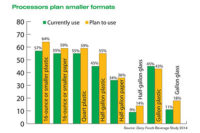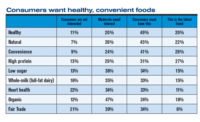Dairy processors are increasing their investment in equipment that produces long-shelf-life beverages and foods. The impetus is a desire to increase annual sales, a need to introduce new products and a need to cut costs.
Those are some results of a new joint Dairy Foods/Food Processing Suppliers Association survey conducted by BNP Market Research, Troy, Mich., this magazine’s research arm. FPSA, based in McLean, Va., is the trade association for suppliers to the food processing and packaging industry.
The objectives of the study were to identify foods and beverages that are currently processed and packaged for long shelf life; to identify areas of growth; and to understand the effects European trends and legislation might have on U.S. processing and packaging of aseptic and extended-shelf-life foods.
Most of the dairy processors replying to the survey said they currently work for or have worked at a company using ESL technologies. Eight percent said their company plans to add ESL/aseptic processing or packaging within the next two years.
Investments to increase
Long-shelf-life dairy products appeal to those surveyed. More than half (55%) said they plan to increase their investments in the production of shelf-stable aseptic products, while 36% will increase investment in the production of refrigerated ESL products. Only 11% said they would decrease their investments in shelf-stable or refrigerated ESL products.
One survey question acknowledged perceptions that aseptic processing is expensive and alters a product’s flavor. The question asked: “There are perceptions that aseptic and ESL processing/packaging can change the product’s flavor and is more expensive than traditional methods used in the United States. Do you expect aseptic and ESL processing and/or packaging to find a place in the U.S. market given these perceptions?” Slightly more than two-thirds (69%) said they expect these products to be accepted.
When it comes to selecting an equipment supplier, price is the No. 1 consideration (43%) followed by expertise in aseptic and ESL technology (39%). Processors also consider after-sales support (32%), a supplier’s experience (28%) and the ability to reduce the cost per case (26%).
On average, survey respondents process five products for extended shelf life. The five most-produced are flavored milk, cream, organic milk, creamers and protein drinks/shakes. Products driving the most growth in the long-shelf-life category are protein drinks/shakes (42%), adult nutrition (26%), sports/performance drinks (25%) and flavored milk, organic milk and yogurt cups (all at 16%).
European trends have an effect
We also asked about potential effects in the United States of the European Union’s plan to lift quotas on April 1. A little more than 25% of U.S. processors said removing quotas will affect the portion sizes they manufacture, while 36% were unsure and 38% said there would be no effect. Similarly, 30% said eliminating quotas would affect their aseptic or ESL processing, while 31% were unsure and 39% foresaw no effect.
On the issue of packaging, 53% of U.S. processors “strongly” or “somewhat” agree that smaller portion sizes in the European market will influence portion sizes in the United States. These processors say they will add smaller packaging to their offerings (34%) or they will replace current sizes with smaller sizes (20%).
The survey also asked dairy processors about the factors having the largest impact on their businesses. Consumer demands by far (50%) were the No. 1 factor followed by capital investment in equipment (15%). The most important factors for future growth are increasing sales volumes, offering new products and reducing overhead costs.
Of those responding to the survey, 39% make fluid beverages; 20% cheese; 15% ice cream/frozen dessert; 12% cultured dairy; 7% butter/margarine; and 1% novelties. Seven percent are involved in sales or marketing. Survey questions were asked in late January and early February. The full survey can be downloaded here.”






